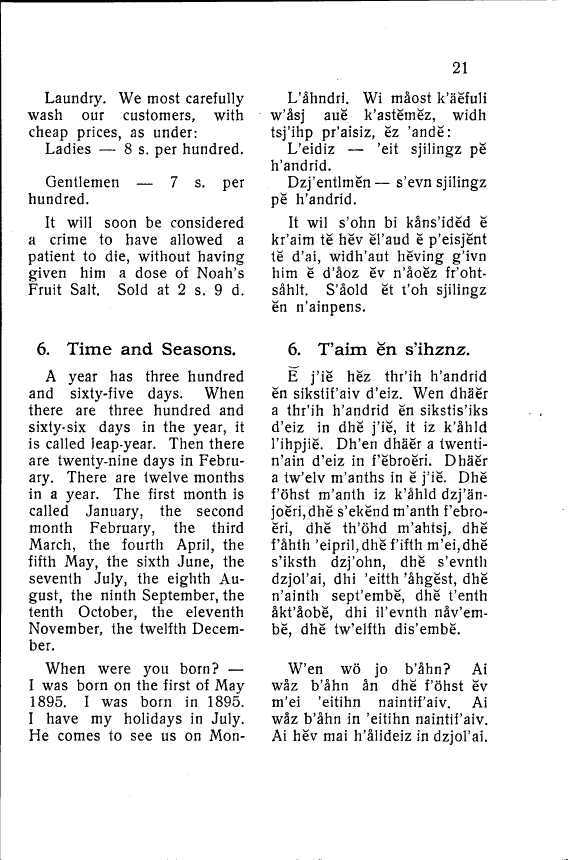
Full resolution (TIFF) - On this page / på denna sida - Läsestycken - 5. Funny Advertisements - 6. Time and Seasons

<< prev. page << föreg. sida << >> nästa sida >> next page >>
Below is the raw OCR text
from the above scanned image.
Do you see an error? Proofread the page now!
Här nedan syns maskintolkade texten från faksimilbilden ovan.
Ser du något fel? Korrekturläs sidan nu!
This page has never been proofread. / Denna sida har aldrig korrekturlästs.
21
Laundry. We most carefully
wash our customers, with
cheap prices, as under:
Ladies — 8s. per hundred.
Gentlemen — 7s. per
hundred.
It will soon be considered
a crime to have allowed a
patient to die, without having
given him a dose of Noah’s
Fruit Salt. Sold at 2 s. 9 d.
L’åhndri. Wi måost k’äĕfuli
w’åsj auĕ k’astĕmĕz, widh
tsj’ihp pr’aisiz, ĕz ’ande:
L’eidiz — ’eit sjilingz pĕ
h’andrid.
Dzj’entlmen — s’evn sjilingz
pĕ h’andrid.
It wil s’ohn bi kåns’idĕd ĕ
kr’aim tĕ hĕv ĕl’aud ĕ p’eisjĕnt
tĕ d’ai, widh’aut hĕving g’ivn
him ĕ d’åoz ĕv n’åoĕz
fr’oht-såhlt. S’åold ĕt t’oh sjilingz
ĕn n’ainpens.
6. Time and Seasons.
A year has three hundred
and sixty-five days. When
there are three hundred and
sixty-six days in the year, it
is called leap-year. Then there
are twenty-nine days in
February. There are twelve months
in a year. The first month is
called January, the second
month February, the third
March, the fourth April, the
fifth May, the sixth June, the
seventh July, the eighth
August, the ninth September, the
tenth October, the eleventh
November, the twelfth
December.
When were you born? —
I was born on the first of May
1895. I was born in 1895.
I have my holidays in July.
He comes to see us on Mon-
6. T’aim ĕn s’ihznz.
E j’iĕ hĕz thr’ih h’andrid
ĕn sikstif’aiv d’eiz. Wen dhäĕr
a thr’ih h’andrid ĕn sikstis’iks
d’eiz in dhĕ j’iĕ, it iz k’åhld
l’ihpjiĕ. Dh’en dhäĕr a
twentin’ain d’eiz in f’ĕbroĕri. Dhäĕr
a tw’elv m’anths in ĕ j’iĕ. Dhĕ
f’öhst m’anth iz k’åhld
dzj’än-joĕri,dhĕ s’ekĕnd m’anth
f’ĕbroĕri, dhĕ th’öhd m’ahtsj, dhĕ
f’ahth ’eipril,dhĕ fifth m’ei,dhĕ
s’iksth dzj’ohn, dhĕ s’evnth
dzjot’ai, dhi ’eitth ’åhgĕst, dhĕ
n’ainth sept’embĕ, dhĕ t’enth
åkt’åobĕ, dhi il’evnth
nåv’em-bĕ, dhĕ tw’elfth dis’embĕ.
W’en wö jo b’åhn? Ai
wåz b’åhn ån dhĕ f’öhst ĕv
m’ei ’eitihn naintif’aiv. Ai
wåz b’åhn in ’eitihn naintif’aiv.
Ai hĕv mai h’ålideiz in dzjol’ai.
<< prev. page << föreg. sida << >> nästa sida >> next page >>